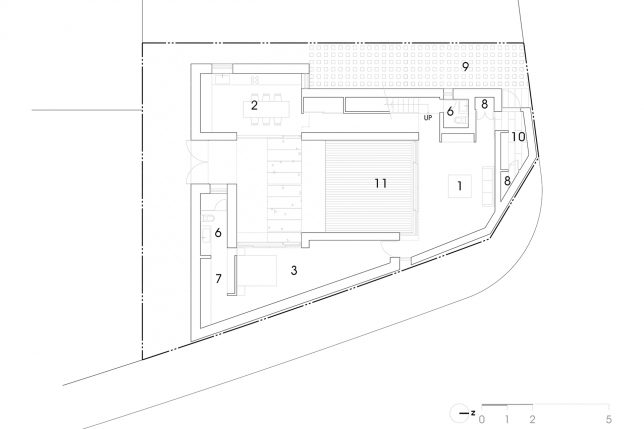
글_정수진 에스아이 건축사사무소 소장
집을 지을 땅, 대지는 집의 성격을 결정짓는 중요한 요소이다. 통념적으로 우리는 경치와 입지가 좋은 곳에 적당한 규모의 반듯한 남향을 좋은 땅이라고 생각한다. 그러나 복잡하고 밀도가 높아진 환경에서 그런 조건을 두루 갖춘 대지를 찾기는 쉽지 않다. 또 대지가 좋다고 무조건 좋은 집이 되는 것도, 대지가 악조건을 가졌다고 무조건 나쁜 집이 되는 것도 아니다. 좋은 땅, 좋은 집의 척도는 절대적인 어떤 기준이 아니라 상호보완적인 여러 상황의 조화에 의해 기능적·미적·경제적 가치가 극대화될 때 그 가치를 제대로 평가받을 수 있다.
합리적인 대지의 선택
집을 짓기 위해 대지를 선택할 때는 건축 과정에서 펼쳐질 여러 상황에 관한 예측-땅 값의 적정성, 주변 환경의 적정성, 해당 지역의 법규 등-과 주변을 둘러싼 지리적·인문적·법적 조건들을 꼼꼼히 살펴보아야 한다. 좁은 땅에서 함께 살아야하는 요즘은 모든 대지가 서로 지켜야할 것들을 법으로 정해 규제를 받고 있는데, 집 짓기에 앞서 복잡하게 얽힌 조건들을 검토해 원하는 목적의 집을 지을 수 있는지부터 살펴보는 것이 가장 먼저 할 일이다.
편안한 대지가 주는 자연스러움
경사진 대지라서 무리하게 그 생김을 변형해 원형을 알아볼 수 없을 만큼 무리하게 평지로 만드는 것은 땅의 자연적인 태생에 역행하는 것이며 경제적인 측면에서도 그다지 효율적이지 못한 방법이다. 평평한 대지에는 편한 집을 지을 수 있지만, 경사진 대지에는 그 경사를 이용한 다양한 기능적·미적 해결 방법이 있기 마련이다.
신중하게 대지를 선택한 다음은 앞으로 펼쳐질 새로운 환경을 어떻게 조화롭게 만들 지가 중요하지 선택한 대지에 억지를 부릴 필요는 없다. 모든 대지는 자신이 가진 고유한 특성이 있으며 집은 그 특성들을 토대로 자연스럽게 형성되는 것이 중요하다.
잘 앉은 집이 주는 정서적 풍요로움
남향의 대지가 좋다는 것은 상식이다. 사계가 뚜렷한 북반구에 위치한 우리나라의 집들은 여름에는 해를 짧게 받고 겨울에는 깊이 집안으로 끌어들여 적절한 실내 온도를 만들도록 자연의 섭리를 최대한 이용한다. 그러나 지나치게 향에 의존하다 보면 자칫 대지의 쓰임에 제약이 되는 경우가 생긴다. 모든 방들이 모두 좋은 향을 갖기는 불가능할뿐더러 좋은 향만 고르다보면 늘 같은 곳만 보는 단점이 생긴다.
향에 버금가는 중요한 조건이 조망이다. 대지 주변에 좋은 경관이 있다면 더할 나위가 없겠지만, 그렇지 못한 경우라도 조망은 여전히 중요한 고려 요소다. 조망이란 보통 멀리 보이는 좋은 경치를 말하지만, 집을 지을 때에는 집 안 구석구석이 주는 아름다움을 느낄 수 있도록하는 안팎의 다채로운 장면들과 변화를 말한다.
향과 조망은 각각 분리된 요소라기보다는 상호보완적인 관계로서 집의 기능과 중요도를 파악해 적절한 자리에 배치되면 서로의 단점을 충분히 보완할 수 있다.

좋은 땅이 정해진 것이 아니 듯, 좋은 집도 앞서 기술한 조건이 절대적인 것은 아니다. 좋은 집은 주어진 환경을 최대한 활용해 단점을 극복할 때 이상적인 결과물로 표현되는 만큼 편중된 기준보다는 중요도 순으로 취사선택과 양보가 필요하다. 대지와 집은 서로 간의 편안한 만남이 이루어질 때 가장 편리하고 정서적으로 안정돼 삶의 풍요로움을 배가시킬 수 있다.
땅이나 집이 생명체는 아니지만 그 안에서 사는 사람들과 더불어 돋보이기도 하고 퇴색되기도 하는 변화하는 존재이다. 집은 움직이거나 말하지는 않지만 삶의 환경을 제공하는 절대적인 입장에서 사람들의 정서에 지대한 영향을 준다.
Written by Sujin Jung | Chief Architect of SIE: Architecture
The land on which a house is built determines the characteristics of a house. Common wisdom dictates that people prefer a big, well located, south-facing, straight piece of land with a good view. However, in modern cities, with their complexity and density, it is not easy to find a site that meets all those conditions. What is more, those conditions for a good site do not necessarily guarantee a good house. The standards for a good site and a good house follow no absolute guidelines. Merit is determined from the interplay of a host of conditions and situations that maximize functional, aesthetic, and economic value.
The choice of a reasonable site
When choosing a site on which to build a house, an architect has to predict the various geographical, humanistic, and legal challenges in the construction process, the land price and neighborhood, and the legal regulations of the area. These days in areas where a large population is densely packed onto small pockets of land, zoning is heavily regulated. The first step to building a house is to review the complex conditions regarding the construction of the intended house.
Naturalness of a comfortable site
An odd-shaped or steep site does not make it a bad place to build a house. Uneven land shapes have their own role. Although it may be easier to build conventionally shaped houses on standard-shaped sites, there is an element of fun that an odd shape can provide.
Leveling and flattening the odd-shaped sites into standard shapes goes against the ecological origins of the land and is cost-inefficient. The oddness and steepness of the site bears its own functional and aesthetic solutions.
Once you have carefully selected the site, the next step is to create harmony between the new house and its surrounding environment. All sites have their unique characteristics and the houses that will rest upon them are created naturally based on these features.
The emotional fulfillment of a well-placed house
It is commonly thought best for a house to face south. The Korean peninsula is located in the northern hemisphere, with four distinct seasons. Homes are therefore designed to maximize the provisions of nature for less summer sun exposure and for deep winter sun. However, an over-obsession with orientation creates limitations. It is almost impossible to have all the rooms in a house facing the best direction, or they will all be facing the same way.
Another important factor other than orientation is the view. Ideally a house will be surrounded with beautiful views. But even when the scenery is less than perfect, the view matters. While we may think of a view as being something in a person’s long-distance vision, in architecture a view can be the miscellaneous scenes and transitions within and outside every corner of a house. When it comes to the function of a house, orientation and view are complementary.

Because there is no one good site, the conditions mentioned above are not the absolute determiners of a good house. Rather, good houses are the ideal result of overcoming disadvantages and maximizing an environment. You therefore have to pick and choose the right or most important elements for the site rather than adhere to stereotypical standards. Fulfillment is achieved when the site and the house are situated in comfortable complementarity.
Neither the site nor the house is an organism, but each one is something that can embellish or discolor the lives of the occupants. A house cannot move or talk, but it profoundly influences people’s emotions by providing crucial life environments.

